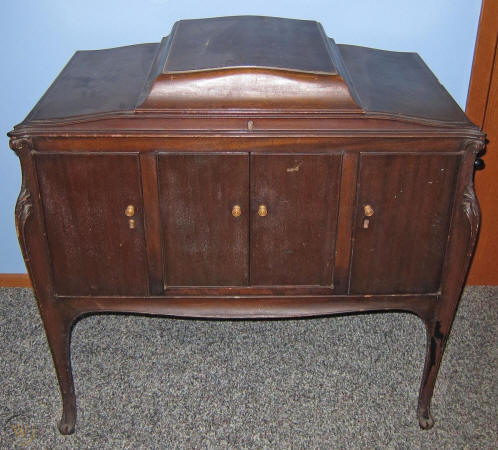
The Victor-Victrola Page

VV-300 / VE-300
RARITY: ¤¤ VALUE: ¤

 The
VV-300 was Victor's first 'console-style' phonograph, introduced in the
summer of 1921. Its debut was concurrent with the reorganizing of the entire
Victrola product line. These new models used conventional Arabic number
designations rather than the previous Roman numerals, but they were essentially
cosmetic variations of the same products that had been offered since 1906. The resounding success of console-style models which
were being produced by other phonograph manufacturers likely motivated Victor to
produce its own line of machines in the 'lowboy' horizontal style; however, the company did not want to mimic designs that others had
produced, so their first console machines had a 'hump-top' appearance. This
concept replicated the domed-lid profile that had been in use on their upright
phonograph models since 1907. The end-result was a rather strange looking
cabinet that was neither very practical (one could not place anything on top of
the machine since all surfaces were angled), nor particularly appealing.
The
VV-300 was Victor's first 'console-style' phonograph, introduced in the
summer of 1921. Its debut was concurrent with the reorganizing of the entire
Victrola product line. These new models used conventional Arabic number
designations rather than the previous Roman numerals, but they were essentially
cosmetic variations of the same products that had been offered since 1906. The resounding success of console-style models which
were being produced by other phonograph manufacturers likely motivated Victor to
produce its own line of machines in the 'lowboy' horizontal style; however, the company did not want to mimic designs that others had
produced, so their first console machines had a 'hump-top' appearance. This
concept replicated the domed-lid profile that had been in use on their upright
phonograph models since 1907. The end-result was a rather strange looking
cabinet that was neither very practical (one could not place anything on top of
the machine since all surfaces were angled), nor particularly appealing.
The VV-300 was definitely considered to be a premium
machine, featuring gold-plated hardware, Victor's best 4-spring motor, as well
as small hand-carved trim details on the corner posts. VV-300 models were
produced in a choice of a mahogany, walnut or oak veneer. The original
1921 selling price of the VV-300 was $250.00, which equates to over $5,400.00 in
today's money. Based on factory documentation, just over 27,000 VV-300 machines were produced.
When it was first introduced in June 1921, the VV-300 received a lot of public attention
and sold moderately well; but by the end of the year the unusual design became
a deterrent for many buyers (which was true for virtually all of the hump-top models). The
public now preferred the practicality and appearance of flat-top console
phonographs, which were being offered by several competitors.
Victor's flat-top console machines (such as the VV-215)
were hurriedly introduced the following year, and quickly outsold the hump-top
Victrolas by a wide margin. The writing was on the wall; by the summer of 1922,
Victor was ramping-down production of the VV-300 and most of the other hump-top
models.
Victor ultimately produced more of these models than could be sold
at list price. As stated above, production of the VV-300 was terminated in the
final months of 1922; however, since so many
remained in storage, it continued to be listed in both the 1923 and 1924 Victrola catalogs. Due to this overproduction, it is quite likely that
many VV-300 machines were sold during Victor's well-advertised "half-price" sale
during the summer of 1925. For more information on Victor's financial crisis of
1924-1925 and the overproduction of phonographs, please click
here.
Electric versions (VE) of the 300 were produced in 1921 and 1922, but this was
not a popular choice; only about 2,000 electric VE-300 models were made. The addition of
the electric motor added $65.00 to the list price.
Note that large groups of serial numbers were skipped during production for both
the VV-300 and VE-300 machines, meaning that the total number of machines
produced and the highest serial number will not be correlated.
In general, collector interest in the VV-300 (and many similar console-style
Victrola models) is weak today. The minimal ornamentation and awkward designs of these later-vintage Victrolas provide (in the view of
many) a far less appealing package than can be found in some of the elegant upright models.
The survival database
currently shows the earliest existent VV-300 to be S/N 667 and the latest to be
S/N 27572
The earliest logged VE-300 survivor is S/N 509 and the latest is S/N 2561
Do you own a Victrola VV-300? Please take a moment and enter some basic information about your machine into the collector's database by clicking here. No personal information is required.